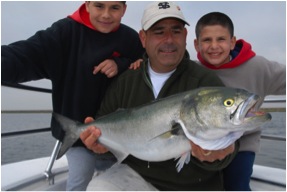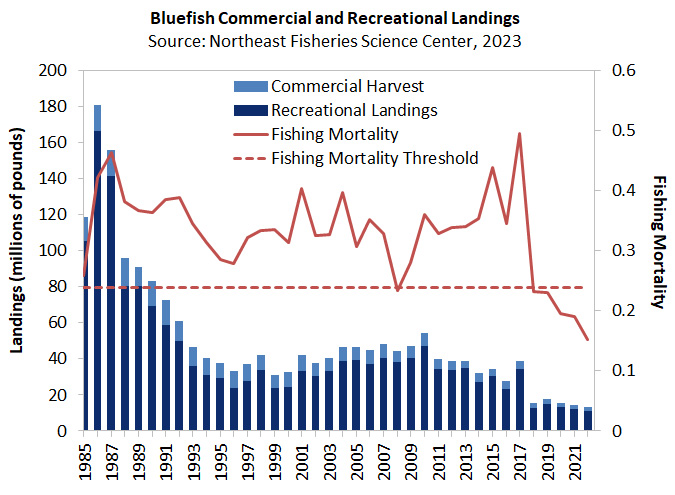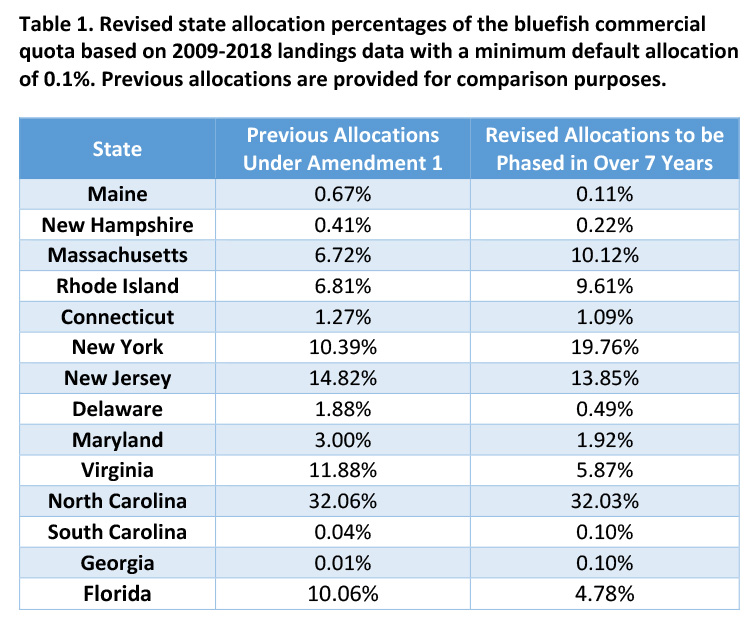Bluefish
Life History

One of the most popular recreational fish along the Atlantic coast, a father and sons with a bluefish. Photo credit: John McMurray, www.nyflyfishing.com
Bluefish (Pomatomus saltatrix) are a migratory, oceanic species found throughout the world in most temperate, coastal regions, except the eastern Pacific. Bluefish migrate seasonally, moving north in spring and summer as water temperatures rise and moving south in autumn and winter to waters in the South Atlantic Bight. During the summer, concentrations of bluefish are found in waters from Maine to Cape Hatteras, North Carolina. In winter they tend to be found offshore between Cape Hatteras and Florida. Bluefish generally school by size, with schools that can cover tens of square miles of ocean, equivalent to around 10,000 football fields.
Bluefish are fast growers and opportunistic predators, feeding voraciously on almost any prey they can capture. Bluefish live up to 12 years and may exceed lengths of 39" and weights of 31 pounds. Bluefish reach sexual maturity at age two and spawn offshore from Massachusetts through Florida. Discrete groups spawn at different times and are referred to by the season in which they spawn: the spring-spawned cohort and the summer-spawned cohort. Recent research has also identified a fall-spawned cohort, demonstrating an expanded and prolonged spawning season. The cohorts mix extensively on the fishing grounds and probably comprise a single genetic stock.
Commercial & Recreational Fisheries

Bluefish are predominantly a recreational fishery, with recreational landings accounting for approximately 86% of total landings by weight in recent years. As bluefish migrate seasonally up and down the Atlantic coast, anglers from Maine to Florida target these voracious predators near inlets, shoals, and rips, where they come to feed on large schools of bait. Recreational harvest peaked at 166 million pounds in 1986, but quickly declined in the 80s and 90s to its current average annual recreational harvest of approximately 21 million pounds. In 2022, recreational anglers harvested an estimated 6.4 million fish weighing 11 million pounds. Harvest during 2018-2022 was exceptionally low compared to the ten-year average. Bluefish recreational releases have averaged approximately two thirds of the total catch in numbers of fish since 1999.
Commercial landings decreased from 13.5 million pounds in 1985 to 7.4 million pounds in 1999. Since a state-specific quota system was implemented in 2000, commercial landings have averaged around 5.5 million pounds annually. 2022 marks a commercial landings time series low of 2.3 million pounds. The majority of bluefish were landed in North Carolina, New York, and Massachusetts in 2022.
Stock Status

The 2019 operational assessment for bluefish indicated the stock as overfished, but overfishing was not occurring. In 2022, a research track stock assessment, which can incorporate larger revisions to the stock assessment model was conducted to inform the upcoming 2023 management track stock assessment for the species. The research track stock assessment made a number of notable data and model changes designed to improve the assessment and reduce uncertainty. Results of the 2023 management track stock assessment conducted by the Northeast Fisheries Science Center found the Atlantic bluefish stock was not overfished and not experiencing overfishing in 2022. Although the stock is no longer overfished, Atlantic bluefish will remain in the rebuilding plan outlined in Amendment 2 until the stock rebuilds to the target level of spawning stock biomass (SSB). The updated stock assessment incorporated data through 2022. SSB in 2022 was estimated to be 116 million pounds, which is 60% of the SSB target.
Fishing mortality (F) in 2022 was estimated to be 0.152, which is 64% of the overfishing threshold of 0.239. Although fishing mortality was below the threshold in 2022, fishing mortality exceeded the updated threshold every year from 1985 to 2017, except 2008. The largest recruitment in the time series occurred in 1985 at 353 million fish, and the lowest recruitment was in 2016 at 70 million fish. Recruitment has increased every year since 2019, but has remined below the time series average over the past 12 years except in 2022. The next management track stock assessment for bluefish is scheduled for 2025.
Atlantic Coastal Management

In June of 2021, the Board and Council jointly recommended approval of Amendment 2 (the Bluefish Allocation and Rebuilding Amendment) to the Interstate Fishery Management Plan (FMP) for Bluefish. The Amendment updates the FMP goals and objectives, initiates a 7-year rebuilding plan, establishes new allocations between the commercial and recreational sectors, implements new commercial allocations to the states, revises the process for quota transfers between sectors, and revises how the management plan accounts for management uncertainty. Bluefish are now managed under Amendments 1 and 2 and Addendum I.
Since the passage of Addendum I in 2012, a coastwide biological sampling program has been underway to improve the quantity and quality of information used in future bluefish stock assessments. Amendment 2 to the Bluefish FMP allocates 86% of the resource to recreational fisheries and 14% to commercial fisheries. Annually, a portion of the recreational or the commercial sector’s quota can be transferred to the other sector (not to exceed 10% of the ABC) if it is anticipated that one of the sectors will not harvest its full quota. The commercial fishery is controlled through state-by-state quotas based on historic landings from 2009-2018. These new state-by-state quotas implemented through Amendment 2 will be phased in over a seven-year period to minimize the economic impact on commercial fisheries. The recreational fishery is managed under a coastwide 3-fish bag limit for private anglers and shore-based fishermen, and a 5-fish bag limit for for-hire fishermen.
Based on the 2023 stock assessment findings and rebuilding plan projections, the Board and Council set new specifications for the 2024 and 2025 fishing seasons. For 2024, the commercial quota was set at 2.42 million pounds and the recreational harvest limit (RHL) was set at 11.96 million pounds. Compared to 2023 landings limits, this represents a 44% decrease in the commercial quota and a 15% decrease in the RHL in 2024. Despite the decrease in the 2024 RHL, no changes were made to recreational measures because 2023 harvest is expected to achieve but not exceed the RHL.
Management Plans & FMP Reviews
- Addendum II: Harvest Control Rule for Recreational Management of Summer Flounder, Scup, Black Sea Bass and Bluefish (June 2022)
- Amendment 2 to the Interstate FMP for Bluefish: Allocation and Rebuilding Amendment (August 2021)
- Addendum I: Biological Monitoring Program (revised 2021) (February 2012)
- Amendment 1 to the Fishery Management Plan for the Bluefish Fishery (January 1998)
- Fishery Management Plan for Bluefish (October 1989)
Stock Assessment Reports
- 2023 Bluefish Management Track Assessment Report (Jun 2023)
- Bluefish Assessment Update (Dec 2021)
- Bluefish Data Update (Dec 2020)
- NEFSC Operational Assessment of the Black Sea Bass, Scup, Bluefish, and Monkfish Stocks, Updated Through 2018 (Dec 2019)
- Bluefish Operational Assessment (Jul 2019)
- Bluefish Assessment Update (Feb 2019)
- Bluefish Benchmark Stock Assessment for 2015 (Aug 2015)
- 2014 Bluefish Stock Assessment Update (Jul 2014)
- 2013 Bluefish Stock Assessment Update (Jul 2013)
- 2012 Bluefish Stock Assessment Update (Jul 2012)
- 2011 Bluefish Stock Assessment Update (Jun 2011)
- 2010 Bluefish Assessment Summary (Jun 2010)
- 2009 Bluefish Assessment Summary (Jun 2009)
- 2008 Bluefish Assessment Summary (Jul 2008)
- 2007 Bluefish Assessment Summary (Jun 2007)
- 41st SAW Bluefish Assessment Summary (Jun 2005)
Meeting Summaries & Reports
Press Releases
- MAFMC & ASMFC Take First Step Toward Recreational Management Reform for Bluefish, Summer Flounder, Scup and Black Sea Bass (June 2022)
- ASMFC Releases Draft Addenda on Recreational Harvest Control Rule for Public Comment: States to Conduct Webinar Hearings in March & April (March 2022)
- ASMFC Schedules State Data Review Workshop for Bluefish for November 3-4, 2021 (September 2021)
- ASMFC & MAFMC Set Specifications for Jointly Managed Species Summer Flounder, Scup, Black Sea Bass, and Bluefish (August 2021)
- ASMFC Approves Amendment 2 to the Bluefish FMP to Adjust Allocation and Establish a Rebuilding Plan (August 2021)
- MAFMC and ASMFC Approve Bluefish Rebuilding Plan and Revised Allocations (June 2021)
- Council and Commission Recommend Recreational Bluefish Management Measures for 2020 (December 2019)
- ASMFC & MAFMC Set Specifications for Jointly Managed Species and Initiate a Joint Action on Summer Flounder, Scup, and Black Sea Bass Commercial/Recreational Allocations; and ASMFC Initiates Addendum on Black Sea Bass State-by-State Commercial Allocati (October 2019)
- ASMFC & MAFMC Approve Catch and Landings Limits for Summer Flounder, Scup, Black Sea Bass and Bluefish for 2019 (August 2018)
- Mid-Atlantic Fishery Management Council and Atlantic States Marine Fisheries Commission to Hold Scoping Hearings for Bluefish Allocation Amendment (June 2018)
- ASMFC Approves Black Sea Bass Draft Addendum XXX for Public Comment & ASMFC and MAFMC Initiate Bluefish Amendment (December 2017)
- ASMFC & MAFMC Maintain Multi-Year Specifications for Black Sea Bass, Bluefish, and Scup and Modify Summer Flounder Specifications (August 2016)
- ASMFC Summer Flounder, Scup, and Black Sea Bass and Bluefish Management Boards to Meet Via Conference Call to Review Recent Recreational Harvest Estimates (June 2016)
- ASMFC & MAFMC Approve Summer Flounder, Scup, Black Sea Bass, and Bluefish Annual Specifications (August 2015)
- ASMFC & MAFMC Maintain Specifications for 2015 Summer Flounder, Scup, Black Sea Bass Fisheries & Approve 2015 Bluefish Specifications: MAFMC Suspends Research Set Aside Program (August 2014)
- ASMFC & Mid-Atlantic Council Approve Summer Flounder, Scup, Black Sea Bass and Bluefish Specifications and Terms of Reference for 2014 Bluefish Benchmark Stock Assessment (October 2013)
- ASMFC & Mid-Atlantic Council Approve Summer Flounder, Scup, Black Sea Bass and Bluefish Annual Specifications and Initiate Development of Draft Amendment to the Scup FMP (August 2012)
- ASMFC Bluefish Board Approves Coastwide Sampling Program to Improve Data used in Stock Assessment (February 2012)
- ASMFC & Mid-Atlantic Council Approve 2012 Specifications for Summer Flounder, Scup, Black Sea Bass and Bluefish (August 2011)
- ASMFC & Mid-Atlantic Council Approve 2011 TALs for Summer Flounder, Scup, Black Sea Bass and Bluefish (August 2010)
- ASMFC & Mid-Atlantic Council Approve 2010 TALs for Summer Flounder, Scup, Black Sea Bass and Bluefish (August 2009)
- ASMFC Approves 2008 TALs for Summer Flounder, Scup, Black Sea Bass, and Bluefish (August 2007)
- ASMFC & MAFMC Approve 2006 TALs for Bluefish, Scup and Black Sea Bass (August 2005)
- ASMFC & MAFMC Approve 2005 TALs for Bluefish, Summer Flounder, Scup and Black Sea Bass: Assessments Show Continued Improvements to Summer Flounder & Black Sea Bass Stocks (August 2004)